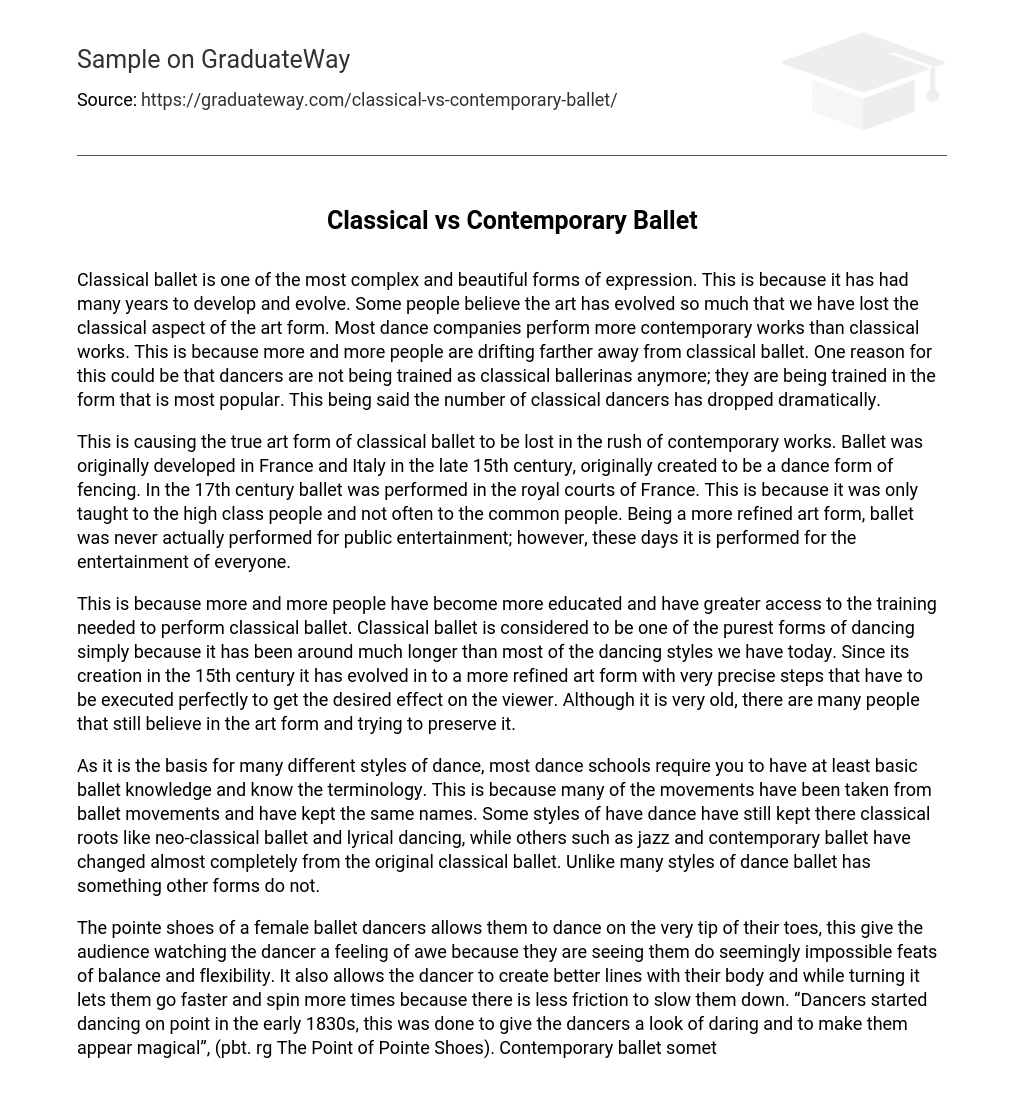The complexity and beauty of classical ballet stem from its long history of development and evolution. However, some argue that the art form has veered too far from its classical roots. Nowadays, dance companies tend to favor contemporary pieces over classical ones, reflecting a growing trend of moving away from classical ballet. This shift may be attributed to the training of dancers, who are now being taught the most popular form rather than strictly classical techniques. Consequently, the number of classical dancers has significantly declined.
The rush of contemporary works is causing the loss of the true art form of classical ballet. Ballet, which was originally developed in France and Italy in the late 15th century as a dance form derived from fencing, was performed exclusively in the royal courts of France during the 17th century. It was only taught to the high class individuals and not often accessible to the common people. Despite its refined nature, ballet is now performed for public entertainment.
With the increasing education and accessibility to training for classical ballet, it has become a very pure form of dance. Its long history dates back to the 15th century, and over time, it has evolved into a highly refined art with precise steps that must be flawlessly executed to make an impact on viewers. Despite its age, there are still many advocates working towards preserving this art form.
Most dance schools require basic ballet knowledge and terminology as it serves as the foundation for various dance styles. Many movements in different styles derive from ballet and retain the same names. While some dance styles like neo-classical ballet and lyrical dancing still hold on to their classical roots, others like jazz and contemporary ballet have undergone significant changes from classical ballet. Unlike other dance forms, ballet possesses unique qualities.
The female ballet dancer’s pointe shoes enable them to dance on the tips of their toes, creating a mesmerizing display of balance and flexibility that leaves the audience in awe. This footwear also enhances the dancer’s body lines and allows for faster turns and more spins due to reduced friction. The concept of dancing on pointe was introduced in the early 1830s to give dancers a daring and magical appearance (pbt. org The Point of Pointe Shoes). While contemporary ballet sometimes incorporates pointe shoes, it is more common for dancers to perform on flat or bare feet in order to execute unconventional movements with greater ease. Contemporary ballet, which is the most popular style of ballet today, has evolved so much from its original form that it can almost be considered a distinct genre of dance. This is due to its unique movements and the way dancers create abstract shapes with their bodies.
Although contemporary ballet differs greatly from classical ballet, it is often regarded as the future of ballet and has a reduced impact on the dance community. This perspective is supported by its modernization, which enables a wider audience to appreciate its diverse performances. Moreover, contemporary ballet emphasizes natural movement more significantly, making it more accessible and providing opportunities for a broader range of dancers who can meet its requirements. Consequently, ballet dancers transitioning to contemporary ballet often undergo retraining to embrace a more organic style of movement.
Classical ballet necessitates extensive training, resulting in a greater number of schools for aspiring dancers. The School of American Ballet (SAB), known for producing exceptional dancers, is considered one of the country’s top ballet schools. To pursue a successful ballet career, one must begin training at a young age due to the intense physical demands ballet places on the body and it takes years for a dancer’s body to adapt to this strain.
Additionally, perfecting the technique required for classical ballet necessitates extensive training. Professional ballet dancers often rehearse for 6-8 hours daily, while trainee dancers in classical ballet schools may have classes lasting anywhere from 45 minutes to over 3 hours, especially older students.
In contrast, contemporary ballet schools are not as abundant due to the diverse performance and design aspects of this art form.
In spite of this, it is challenging to be trained in a fixed style. Classical ballet, conversely, has precise and predetermined movement, even though the execution may differ among teachers, the steps remain unchanged. While professional contemporary dancers have to rehearse just as much as classical dancers, their preparation for a contemporary company job is not as straightforward as it is for a classical company job. Currently, there is a blurred distinction between classical ballet companies and contemporary ballet companies.
As ballet evolves, many companies are incorporating both contemporary works and classical ballets. However, as classical ballet fades into the past, choreographers are reluctant to create new works in this style. Therefore, to compensate, companies are incorporating more contemporary pieces into their repertoire each season. Consequently, classically trained ballet dancers are now required to adapt to the challenging movements and positions of contemporary dance (Sims).
Despite the physical demands on a dancer’s body, dancing enables them to develop strong muscles and achieve a high level of flexibility in the back and legs through years of stretching and practicing challenging positions. While classical ballet requires holding sharp and precise positions, contemporary ballet allows for more natural and comfortable poses. Some may argue that although classical ballet careers are shorter, they are more fulfilling.
As contemporary ballet becomes increasingly dominant, there are differing viewpoints on the career paths chosen by individuals. It seems that many people are opting for the easier route rather than pursuing a more fulfilling one. However, pursuing a career in ballet is not only amazing but also beneficial for physical and mental health. This is because it necessitates immense concentration and hard work to develop the strength needed to learn and perform the demanding movements. Although classical ballet can be more difficult and less forgiving, it provides a sense of achievement and allows you to accomplish something that others might perceive as impossible.





